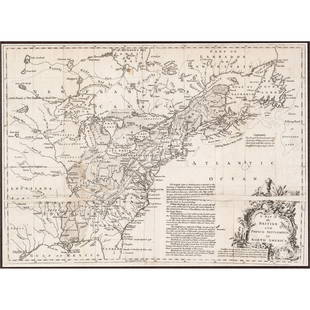
FRENCH PHOENIX INDIAN TRADE BUTTON
Similar Sale History



Recommended Items





Item Details
Description
FRENCH PHOENIX INDIAN TRADE BUTTON Je renais de mes Cendres No. 26 The Phoenix button has a storied history. There is a small bird in the middle with the words, "JE RENAIS DE MES CENDRES." around it. Under the bird is a number. The translation is "I rose from my own ashes." Once plentiful, today they are very scarce. The two being offered today were found a foot underground on Sauvies Island in 1960, just before a building foundation was to be poured with cement. The history of the button starts with Henry Christophe, king of Haiti in 1807. For 12 years prior to Christophe’s kingship, Haitian slaves revolted against their European masters and defeated the English, Spanish and French. In 1802 the French anchored 225 ships in the harbor with 60,000 troops to put down the revolt. The Haitians were greatly outmanned and out gunned, but defeated the French, and by 1803 the French army was spent. Thomas Jefferson quickly took advantage of Napoleon and a French army in desperate need of cash, and convinced him to sell the Louisiana territory for 15 million dollars. Known as the Louisiana Purchase. Christophe reigned as king until 1820 when he became ill, and was too weak to put down a coup. He committed suicide that same year. The phoenix was Christophe's coat of arms. All of his troops were outfitted with uniform buttons and buckles with this phoenix design. The numbers at the bottom of the buttons denoted the regiment number. The buttons are numbered 1-30 with 11-13, 15-19 and 21-24 being skipped. One theory is they were skipped intentionally to fool enemies into believing the army was larger than it really was. Much of the accepted theory on the Phoenix Buttons can be accredited to Emory Strong, who was a button collector and amateur archaeologist from the Portland Oregon area The disc style buttons came in 3 sizes: 17, 25 and 26mm, and were made of polished brass. They were a 1 piece die stamped brass buttons with a soldered back loop. The ball variety came in two sizes; 13 and 17mm and were made of copper with a silver gliding. After 1820 the After Christophe’s death the history of the Phoenix Button becomes cloudy. The button maker or makers apparently sold the undelivered buttons to a trading company bound for the West Coast of the United States. Very little information is available about the manufacturer. The only buttons with back marks are the ball variety, and all are marked "BUSHBY LONDON." No records have been found on this English company, so whether they were the only maker is unclear. Nathaniel Wyeth a trader was in the process of setting up a trading post on Sauvies Island near present day Portland, Oregon. It is generally accepted that he was the one that the buttons were sold to in England. One of the ships believed to be carrying the buttons made a stop in Hawaii, and one of the buttons was found in Hawaii several years ago. Almost all of the buttons made their way to Wyeth's trading post. Here, they were believed to be traded to the Indians. The Indians in turn traded with other tribes, and eventually the buttons made their way up and down the West Coast. The buttons have been found at period sites from Alaska to Southern California. Of the 10 or so buttons that have been reported east of the Rocky Mountains, 3 have come from Virginia. Country: US Size: 17mm
Condition
Good.
Buyer's Premium
- 21%
FRENCH PHOENIX INDIAN TRADE BUTTON
Estimate $50 - $150
1 bidder is watching this item.
Shipping & Pickup Options
Item located in Tallahassee, FL, usSee Policy for Shipping
Payment

Related Searches
TOP















































